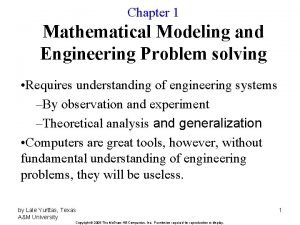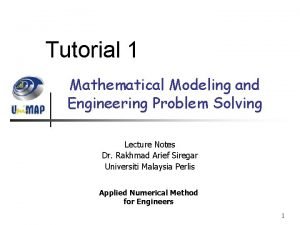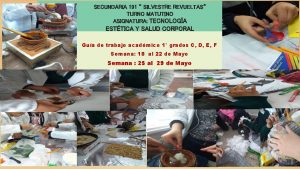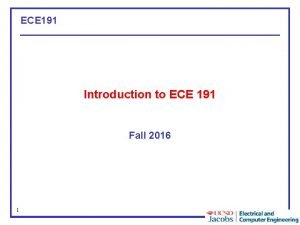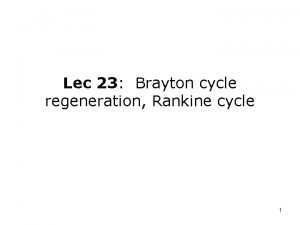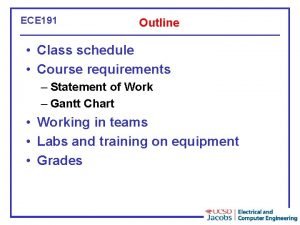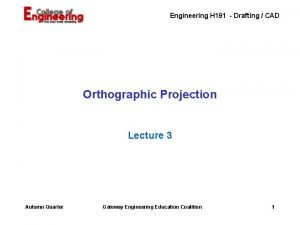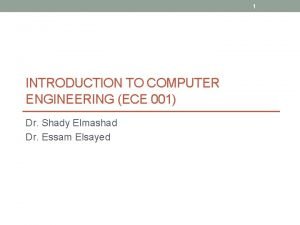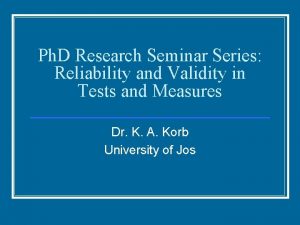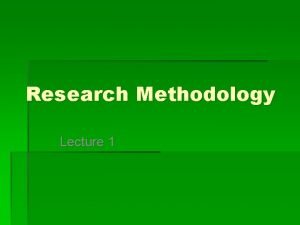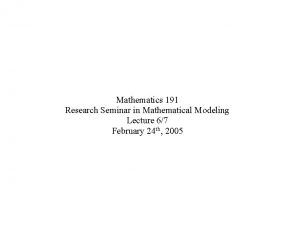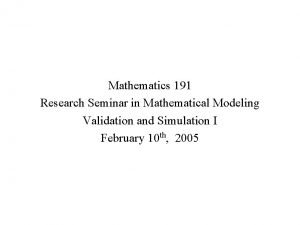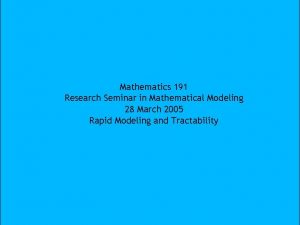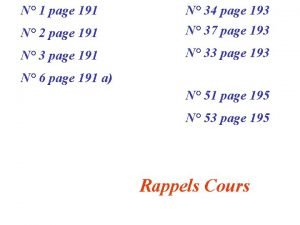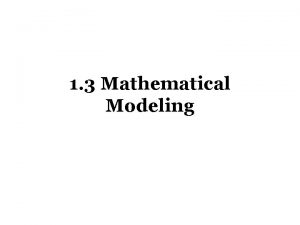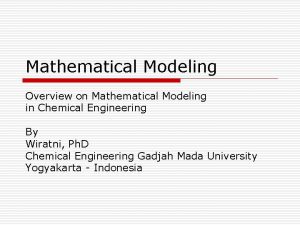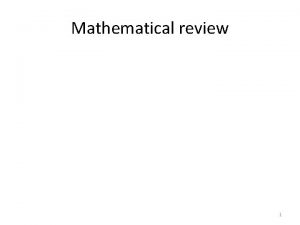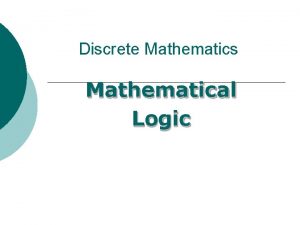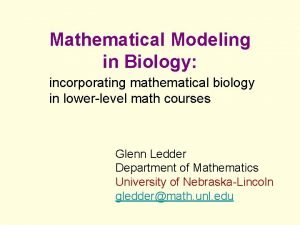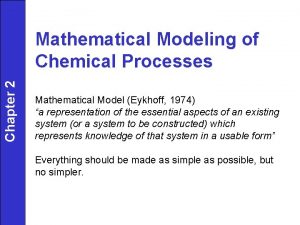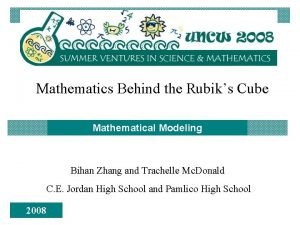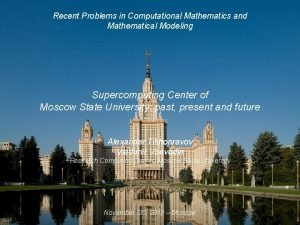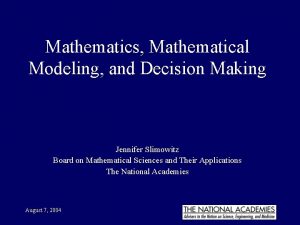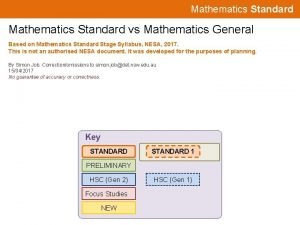Mathematics 191 Research Seminar in Mathematical Modeling Lecture






























- Slides: 30

Mathematics 191 Research Seminar in Mathematical Modeling Lecture 3 Introduction to Modeling, Part 2 January 26 th, 2005

Recap ● ● Last time we discussed reduction of a problem from vague, open-ended questions in other fields into something that is more mathematically rigorous Our key example was grade inflation, and we discussed turning a question with multiple interpretations into a more concrete statement, but we didn't talk at all about how to proceed after that point. Today, we'll talk about what comes next – we'll begin the process of model-building itself. We'll find that our intuitive understanding of real-world systems will often provide us with enough insight to construct a predictive model.

Overview ● Quantifying Real-world Factors ● Classification of Variables ● Variables in Unknown Systems ● Case Study: Tsunami Damage Models ● Case Study: Tsunami Relief Models ● Parameters versus Assumptions ● Dependencies ● Case Study: Tsunami Relief ● Case Study: Wide World of Models ● Administrative Matters

The Modeling Process ● Statement of Problem (abstraction) ● Define Model Objective / Objective Function ● Definitions and Identification of Variables (background research and common sense) ● Assumptions (for tractability) ● Establish Informal Relationships Based on System ● Construct Mathematical Statements ● Construct Base Model ● Estimate Parameters ● Apply Mathematical Methods ● Pure Mathematical Solution ● Simulation and Validation (the inverse of the abstraction process) ● Sensitivity Analysis ● Relax Assumptions ● Iterate ● Assess Model Limitations

What matters in real-world systems? ● ● The first step after we have our problem constructed and goal in mind is to ask ourselves what factors play a role in the system we're thinking about. In model construction we simply define these factors as variables. Real-world systems are often extremely complex and many factors play a role. In grade inflation, for instance, we might think about student GPA as an obvious variable, but we might not think of faculty tenure as another. In many (usually economic) models there are factors that are difficult to quantify, that seem subjective, or that even attempt to represent human emotion or behavior. What do we do with these type of factors?

Today: Model Variables ● ● ● Modeling is driven by defining relationships between a set of real-world factors in a given system. In mathematical modeling, just like in programming, we begin by declaring our variables This is the first step in actual modeling, but at this point we still haven't attached ourselves to any specific mathematical methods.

A Simple Example ● Let's say we're shopping for a car. What factors do we consider?

● ● Many of these variables were not quantitative on their surface. We have three choices: rephrase the problem to avoid dealing with them, reduce them to quantitative terms, or to make assumptions about our system Our preference should be reduction, but this is not always possible due to time, complexity, or interest. How do we reduce “driving habits”?

Identifying Key Variables ● ● ● How do we come up with variables, especially in a system requiring expert knowledge? Our common sense and intuition will get us further than we think. Beyond that, a little research may help.

Sample Problem: Grade Inflation ● Give a formal statement of the grade inflation problem. Generate a pervasive list of variables.

Classification of Variables ● Exogenous ● Endogenous ● Random, Boolean ● Hidden (hopefully none, but applicable in many cases)

What about systems we don't know about? ● ● One of the powerful things about studying modeling itself is that we can apply this framework to unfamiliar systems. How well can we do in thinking about the variables of what we are modeling, without any advance knowledge of the subject? Why? You will build confidence in entering an unfamiliar field and writing a paper – it's what happens in the MCM.

Case Study: Tsunami modeling ● ● How much damage results from a tsunami? We may be inclined to begin by reading as much as possible about the topic, but it's usually better to consider the problem first – otherwise, it's easy to become overwhelmed with information.


Actual Tsunami Modeling Factors ● ● ● Interest in tsunami modeling has spiked only recently A common approach combines existing advanced models for storm prediction and seismic activity, TAOS/MIDGARD TAOS considers: Still water level, astronomical tide, “surge”, wave setup, wave runup MIDGARD considers epicenter relative to tectonic plate distribution, intensity How well did we do?

What happens if we missed some variables? ● ● There are some occassions when our knowledge of a given system is incomplete, or it's a black-box system like a cognitive process and we don't know all the variables involved. Any guesses?

To Sum Up Modeling Variables Identification of relevant variables for a problem ● ● ● In nonexpert fields, common sense when considering a system will account for 95% of the variable choice Consider -all- the variables that might have an effect, even if the effect is remote. You will develop a knack for naming the most relevant variables first We are biased in favor of quantitative variables, empirically derivable variables, and variables we can determine through additional modeling (in that order).

Mathematical Dependencies ● ● ● What do we do with these variables once we have them? Our next step will be to informally understand the relationships we expect to occur in the system. If you're a mathematician, the easiest way to think of these relationships will be as functions

Tsunami Models, Continued ● Using the tsunami variables from before, establish the functional dependencies of this system.

More on dependencies ● ● Mathematical dependencies should stem from our common sense, but we don't need to worry about a precise form of the statement just yet. That's the modeling itself! After this step we need to decide which parts of the problem we want to model, which parts we want to guess, and which parts we want to assume away.

Problems within the Purview of Modeling ● ● ● Most disciplines are well-established, so the models used have been in existence for hundreds of years. As undergraduates we often consider only existing models in class. This process is so established that we encounter models on a daily basis without always recognizing them as models. However, glory lies in development of our own models. Let's try some samples.

How can we hold fair elections in a dangerous or uncertain environment? ● ● Iraq's electoral system is based loosely on our own. Iraq is divided into a certain set of precincts, but turnout is expected to be fairly low, and perhaps unfairly biased towards certain groups. As an added complication, nobody knows who's really running. In the US election, random votes were lost on certain machines in certain areas. User and machine error, and rarely, fraud, also contributed to mis-votes. Rerunning an election is costly and highly undesirable. How can we still determine a “fair” winner in these situations?

How Did Velociraptors Hunt? ● ● Part 1. Assuming the velociraptor is a solitary hunter, design a mathematical model that describes a hunting strategy for a single velociraptor stalking and chasing a single thescelosaurus as well as the evasive strategy of the prey. Assume that thescelosaurus can always detect the velociraptor when it comes within 15 meters, but may detect the predator at even greater ranges (up to 50 meters) depending upon the habitat and weather conditions. Additionally, due to its physical structure and strength, the velociraptor has a limited turning radius when running at full speed. This radius is estimated to be three times the animal's hip height. On the other hand, thescelosaurus is extremely agile and has a turning radius of 0. 5 meters. Part 2. Assuming more realistically that the velociraptor hunted in pairs, design a new model that describes a hunting strategy for two velociraptors stalking and chasing a single thescelosaurus as well as the evasive strategy of the prey. Use the other assumptions given in Part 1. Here, some constraints and assumptions are given to us by the problem. What sort of mathematical approaches might we use to solve this problem?

How can we detect moving objects in an ambient noise field? ● The world's oceans contain an ambient noise field. Seismic disturbances, surface shipping, and marine mammals are sources that, in different frequency ranges, contribute to this field. We wish to consider how this ambient noise might be used to detect large maving objects, e. g. , submarines located below the ocean surface. Assuming that a submarine makes no intrinsic noise, develop a method for detecting the presence of a moving submarine, its speed, its size, and its direction of travel, using only information obtained by measuring changes to the ambient noise field. Begin with noise at one fixed frequency and amplitude.

How many people should you date in your life? ● ● Consider the sequence of individuals we choose to date over the course of a lifetime (100 or so). Assume for a simple model that once we dump someone, we never see them again. What is the optimal number of people to date before “settling down” to maximize the probability that we'll find Mr. /Ms. Right? In the advanced model, we can “play the field”. . .

First Project ● ● Take an open ended real-world problem, reduce it to a formal problem (ie, state it clearly), identify the variables involved, declare your assumptions, construct a mathematical representation of the system, and solve the problem Discuss your project choice with us in a formal write-up or by meeting with us at office hours. ● Work in teams of two or three, chosen Thursday. ● Participation in the MCM may serve as the basis for your model ● Write a paper outlining your model. Extensive validation won't be required just yet, but take a stab at it all the same. You can make an intelligent effort to comment on effectiveness and accuracy of your model. ● Present your model in a talk ● You may want or be required to contact an expert. ● You will understand the whole model-building process thoroughly by end of this section – so far, we have just covered the set-up.

Crash Course in La. Te. X ● ● Ephrat will schedule a section for La. Te. X paper -writing. When and where? Email us your project ideas. You should meet individually with us after the first project to discuss your interests for the final project.

Assumptions ● ● ● Why do we make assumptions? Because some aspect of a problem is too complex, or we don't have time Why do we want as few assumptions as possible?

Fin

Assumptions ● ● ● Decide which elements of the problem we want to consider. Which variables are outside our reach? Consider also what aspects of the problem are rendering it untractable Some variables are parameters that we can guess values for.
 Modeling role modeling theory
Modeling role modeling theory Relational modeling vs dimensional modeling
Relational modeling vs dimensional modeling Modeling mechanical systems examples
Modeling mechanical systems examples Mathematical modeling and engineering problem solving
Mathematical modeling and engineering problem solving Mathematical modeling and engineering problem solving
Mathematical modeling and engineering problem solving Mathematical vs non mathematical economics
Mathematical vs non mathematical economics Mathematical literacy pictures
Mathematical literacy pictures 01:640:244 lecture notes - lecture 15: plat, idah, farad
01:640:244 lecture notes - lecture 15: plat, idah, farad Ece 191 ucsd
Ece 191 ucsd Escuela secundaria diurna 191 silvestre revueltas
Escuela secundaria diurna 191 silvestre revueltas Iso 191
Iso 191 Morbus paget
Morbus paget Article 191
Article 191 191
191 Ece 191
Ece 191 T-s diagram brayton cycle
T-s diagram brayton cycle Ece 191
Ece 191 H 191
H 191 191 amino acid
191 amino acid Drafting
Drafting 191 kpc
191 kpc Ece 191
Ece 191 Jon keating oxford
Jon keating oxford Construct validity meaning in research
Construct validity meaning in research Research seminar definition
Research seminar definition Notes on research methods
Notes on research methods Slide todoc.com
Slide todoc.com Research meaning
Research meaning Research report vs research proposal
Research report vs research proposal Method procedure example
Method procedure example Ethical considerations examples
Ethical considerations examples



